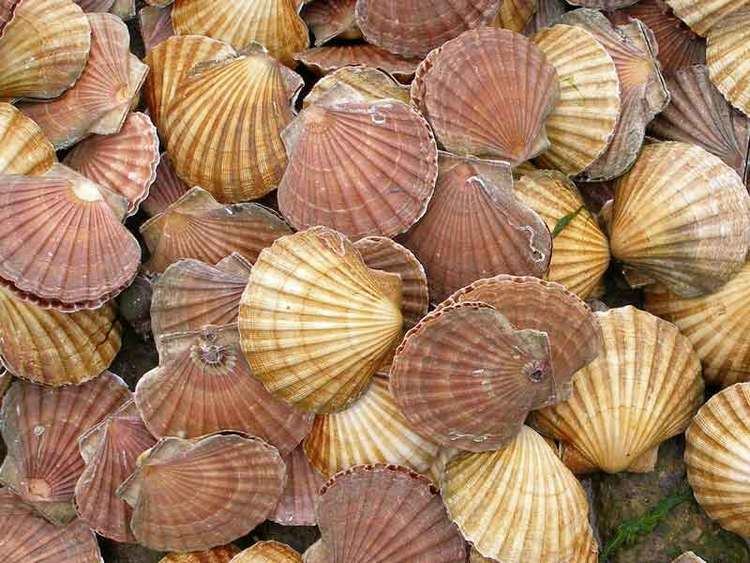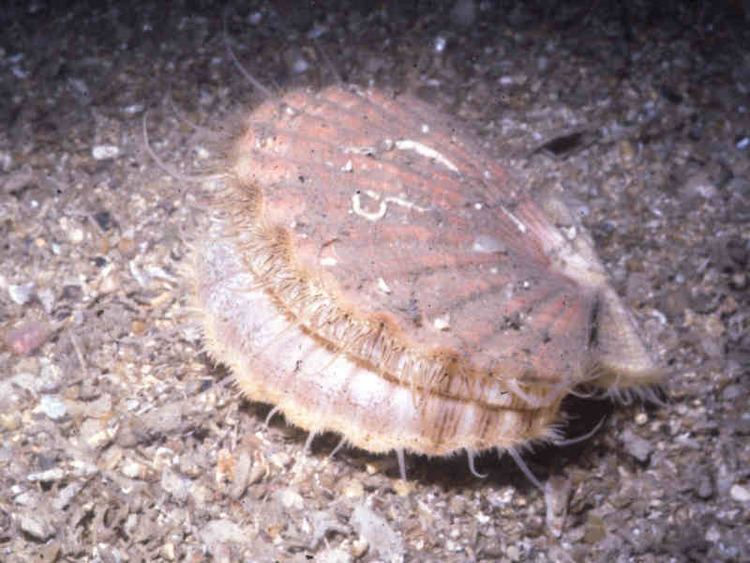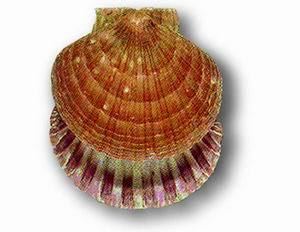Order Ostreoida Superfamily Pectinoidea Scientific name Pecten maximus Rank Species | Suborder Pectinina Higher classification Pecten | |
 | ||
Similar Scallop, Homarus, Pecten, Mytiloida, Bivalvia | ||
Great scallop pecten maximus
Pecten maximus, common names the great scallop, king scallop, St James shell or escallop, is a northeast Atlantic species of scallop, an edible saltwater clam, a marine bivalve mollusc in the family Pectinidae. This is the type species of the genus. This species may be conspecific with Pecten jacobaeus, the pilgrim's scallop, which has a much more restricted distribution.
Contents
- Great scallop pecten maximus
- Description
- Distribution
- Biology
- Predators and diseases
- Fisheries and aquaculture
- Cultural significance
- References

Description
The shell of Pecten maximus is quite robust and is characterised by having "ears" of equal size on either side of the apex. The right, or lower, valve is convex and slightly overlaps the flat left, or upper, valve, which is flat. Larger specimens have an nearly circular outline and the largest may measure 21 cm in length. The "ears" are prominent and are a minimum of half the width of the shell with the byssal notch situated in the right anterior ear being slight and not serrated. The sculpture of the valves is distinctive and consists of 12 to 17 wide radiating ribs and numerous concentric lines which clearly show the scallop's growth history, while the "ears" show a few thin ribs which radiate from the beaks. The radiating ribs reach the margins of the valves wand this creates a crenulated form.. The left valve is normally reddish-brown while the right valve varies from white through cream to shades of pale brown contrasting with pink, red or pale yellow tints; either valve may show zigzag patterns and may also show bands and spots of red, pink or bright yellow.

The colour of the body of Pecten maximus is pink or red with the mantle marbled brown and white. When young they are attached to the substrate by a byssus but mature animals are capable of swimming by the opening and rapid closing of the valves. The adductor muscle which is used to close and open the valves is very large and powerful. The foot is a finger-like organ, which spins the byssal threads, which pass through the byssal notch on the ears. The margin of the mantle has two layers the inner layer is finely fringed while the outer is lined with long tentacles with two series totalling 30-36 dark blue or green simple eyes or ocelli in two rows at their base.
Distribution
Pecten maximus occurs in the eastern Atlantic along the European coast from northern Norway, south to the Iberian peninsula, it has also been reported off West Africa, off the Macaronesian Islands. In Great Britain and Ireland it is distributed all round the coast but it is uncommon and localised on the eastern North Sea coast. It prefers offshore waters down to 100m
Biology

Pecten maximus frequently creates a slight hollow in the substrate for its shell to lie in by opening and closing the valve to eject water from the mantle cavity which raises the shell at an angle to the substrate so that subsequent water jets into the sediment and create a recess. One settled sand, mud, gravel or living organism coat the upper valve and only the margin of the shell, with the tentacles and eyes, is all that is visible. They are filter feeders which extract particles from the surrounding water via a feeding current which is drawn by cilia across the gills where the food particles are trapped then taken to the mouth in stream of mucous.

Pecten maximus swims but this is generally limited to escape reactions, the main predators which cause this reaction when the scallop detects them are the mollusc eating starfish Asterias rubens and Astropecten irregularis while starfish which do not feed on molluscs cause limited jumping or valve-closing reactions. The swimming action is performed by rapidly clapping the valves and expelling jets of water from each side of the hinge so that the it moves with the curved edge of the shell at the front. The scallop jumps by gradually relaxing the adductor muscle and then rapidly opening and closing the valves, causing the scallop to jump forwards.
Pecten maximus tend to be more numerous in areas where they are not fully exposed to strong currents, scallops which live in sheltered habitats grow faster than scallops in areas exposed to wave action, possibly due to the filter feeding apparatus being unable to function because of high concentrations of particulate matter in the water in areas subject to high levels of wave exposure. Another factor that may be significant is that the processes of larval settlement and byssal attachment are rather delicate and would be disturbed in strong currents. Abundance and growth rates are negatively correlated with the amount of mud in the substrate.
Scallops use larval motility to distribute themselves, as the adult scallops have limited mobility. The distribution of the larvae is affected by factors such as local hydrographic regimes and their survival and this results in the scallops having an aggregated distribution within their geographic range. This means that the major fishing grounds are normally widely separated and each fishing ground's environmental conditions mean there are marked differences in structures of the populations, although the genetics of scallops are rather uniform across its range.
The reproductive cycle of Pecten maximus is extremely variable and the spawning may be influenced by both internal and external factors such as age and temperature respectively but is also influenced by genetic adaptation. Generally, mature scallops spawn over the summer months starting in April or May and lasting to September. They are hermaphroditic and have distinct tongue-shaped gonads which are red or orange in colour for the fame=ale gonad and white for the male. and white (male) gonad and it is estimated that a three-year old scallop releases 15 - 21 million oocytes per emission. There appear to be two spawnings in may parts of the range, normally there is a partial one in the Spring and a full one in late August, however younger scallops have a single spawning event in the late summer. In some areas this pattern is reversed and the major spawning is in the Spring. After spawning the animals undergo period of recovery of the gonad before they spawn again. Fertilization of the gametes is external and either sperm or oocytes can be released into the water column first.
As the larval stage of Pecten maximus is relatively long, up to a month, then the potential for dispersal is quite high, even smaller adults can use the byssus to drift too. However, in at least some populations, genetic studies show that there is little contribution from more distant populations and that these populations probably sustain themselves.
In waters around the United Kingdom Pecten maximus become sexually mature at around 2–3 years old and when they reach 80 to 90 mm in shell length. Where they are not exploited they may live for more than 20 years and reach shell lengths of more than 200mm. Scallops in shallow water grow faster than those in deeper water, the growth halts in winter and starts again in spring producing concentric growth rings which are used to age the scallops.
Predators and diseases
As well as Asterias rubens and Astropecten irregularis major predators on Pecten maximus are crabs such as Cancer pagurus, Carcinus maenas, Liocarcinus puberand Liocarcinus depurator will prey on the scallops as they grow. The anemone Anthopleura ballii was found preying on young specimens of P.maximus in south-western Ireland.
The larvae of Pecten maximus are attacked by the bacterium Vibrio pectenicida, which was described in 1998 as a new species after incidents of mortality among cultured scallops in France in the early 1990s. Other strains of pathogenic bacteria were detected in Norway following mass mortalitry of larvae in culture.
Fisheries and aquaculture
In 1999 the total catch reported by the United Nations Food and Agriculture Organisation was 35,411 tonnes with the two biggest catches being reported from the United Kingdom and France which landed 19,108 tonnes and 12.745 tonnes respectively. It is believed that some natural stocks are showing indications of over exploitation resulting in strict enforcement of fisheries legislation and by the development of stock enhancement practices. Great scallops are fished for using Newhaven scallop dredges although a very small percentage, i.e. less than 5% is gathered by hand by divers. In total the scallop fisher for P. maximus. and for the Queen scallop Aequipecten opercularis are one of the top five fisheries by value in United Kingdom waters. However, the use of towed great to harvest scallops causes damage to the wider ecosystem.
Pecten maximus can be cultivated in aquaculture and this is reasonable advanced in France and Norway. Spain, France, Ireland, United Kingdom and Norway have been involved in the aquaculture of scallops, this production peaked 1998 when 512 tonnes were landed but this was followed by a reduction and in 2004 only 213 tonnes was landed, having an estimated value of €852 000, equivalent to €4 per kilogramme.
Pecten maximus has been found to contain the Amnesic Shellfish Poisoning toxin, domoic acid and this means that there is a risk of human illness caused by eating toxic scallops. This risk is regarded as a significant threat to both public health and the shellfish industry.
Cultural significance
The oil company Royal Dutch Shell derives its highly recognizable logo from this species.
Pilgrims travelling to the town of Santiago de Compostella in Galicia took the shells of scallop with them, in honor of Saint James. This gave rise to the alternative name St James shell.
